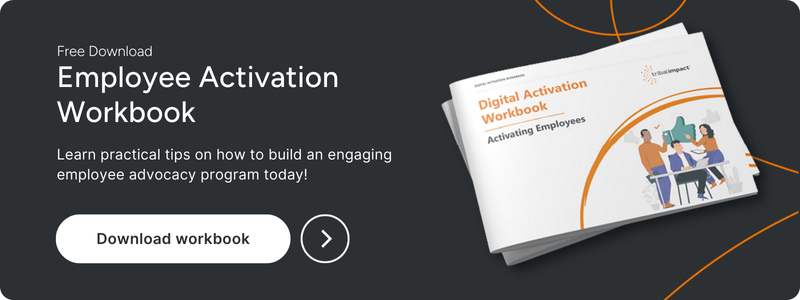98% of employees use at least one social media site for personal use, of which 50% are already posting about their company, so if you're not already on board with employee activation, you could be missing a huge opportunity.
Mercer is already advanced in activating employee voices on social media. With about 38,000 people and over 70 different channels across a myriad of platforms across the globe, they do a tremendous job in bringing conversations to life for their communities internally and externally on social media.
Listen to the podcast below as Sarah Goodall, Tribal Impact CEO, talks to Danielle about the employee advocacy journey, clear ROI, and the benefits of scaling participation.
What is employer branding, and how can it grow your business?
Employer branding is a concept where companies create an image of themselves as an attractive and desirable workplace. It involves marketing techniques to promote the company’s unique culture, values, and mission to attract and retain top talent.Employer branding can help businesses grow by creating a positive reputation that attracts quality candidates, increasing employee engagement, boosting morale, and improving customer satisfaction. Additionally, it can help employers differentiate themselves from competitors in the job market.
What is employee branding, and why your company needs it
Employee branding is the process of creating a positive image and reputation for your company through its employees' actions, words, and attitudes.
It involves creating an identity for your company that resonates with current and potential employees, customers, and other stakeholders. Employee branding helps to create a sense of pride in the company’s values and mission, as well as a strong emotional connection between people and the brand. This can help to attract top talent, increase customer loyalty, differentiate your business from competitors, and boost employee morale.
Danielle says, “Employee advocacy needs to be built around employees, not the brand. However, it can feel daunting for some less progressive and more traditional companies because of unconscious bias about who should be posting about certain topics.”
“You may have employees who write all your thought leadership content who are genuine experts in their field. That person may or may not have a presence digitally, but maybe in other realms. They're on stages, and they’re writing content, they're having really big conversations. And then you've got other employees who don't have that expertise but built a platform externally because they're passionate about this topic. They’re building conversations and elevating points of view.”
“It's important to understand their value here. Assuming what they're doing is not disparaging or harmful to the brand. Everywhere they go, they're creating moments of delight. And people will be asking, who is this person? Oh, this person works at Mercer or Apple, for example. And so, it creates an impression of your brand for free. They're building reach into communities your brand wouldn't otherwise get into without paying for it.”
Employee brand: Is there a risk to brand reputation?
An employee’s brand is the individual’s personal reputation and public image. Employers should strive to ensure that employees reflect their own values and goals, as this will help strengthen both employer and employee brands.
However, how do you protect risk to reputation?
Danielle shares that Mercer is a split organisation because part of their business is investments. She explains how some businesses will be highly regulated, such as investment businesses that are licensed professionals and governed by external regulating bodies. For these types of businesses, employee advocacy will be locked down by compliance and legal and will likely have their own social media policies and restrictions on changing messaging.
“You can have a more progressive social media policy for businesses that are not restricted by governing bodies. For example, Mercer has a policy consisting of two social media PowerPoint slides. Slide one is for the brand, so new employees are informed on what they are accountable and responsible for in adhering to protecting the brand and ensuring that they are working together with the shared purpose and values.
The second slide is simple guidance and more common sense rather than rules because Mercer starts with the relationship of trust. The aim is that everyone contributes towards the same common objectives.
It includes reminders that once something is on social media, it's always on there. Even private chats can be put into a public forum, so it's remembering what they're saying in the context they're being present in and what that means for them as an individual and as an ambassador for the brand.”
Danielle advises keeping guidelines simple and then reinforcing them with regular training.
Can social media be used for talent retention?
80% of respondents look up the social media profiles of current staff when applying for or even considering a position, and 60% of prospective employees research a potential employer on LinkedIn before applying for a role (Source: Capitalize).Talent is critical now more than ever. And leveraging all social channels strategically to attract, engage and retain talent is huge at a time when it's hard to get good people.
“Employee advocacy has an opportunity to help potential talent see the culture of the business. To see within the fabric of the organisation at every touch point, from the candidate experience to hiring, even through to exit.” Danielle explains.
“You empower employees by consistently gaining their perspectives and aligning your shared purpose. For example, asking what is it like to work here? How do people work? How do you communicate? How do you engage? How are you held accountable?.”
You can attract the right talent by empowering your employees' voices. They can shorten the hiring time and bring the right candidates into the process that fits the business’s values. If you start to put those employees out there, it can have a massive impact.
6 ways to encourage advocacy and activate employees
- Create a global employee advocacy program that encourages employees to share company content and updates on their personal social media accounts.
- Leverage the power of peer-to-peer recognition by recognising employees actively advocating for the company on social media.
- Utilise internal communications tools, such as newsletters and intranet sites, to communicate company updates and initiatives to all employees in an engaging way.
- Encourage team collaboration by setting up virtual meetings or webinars to discuss campaigns and strategies across different regions.
- Host global events or webinars that allow employees from different countries to connect, share ideas, and collaborate on projects.
- Offer incentives for employees participating in global advocacy activities such as discounts, gift cards, or special recognition awards at company events or gatherings.
Conclusion
If you've watched the video or listened to the podcast, you'll know Danielle has much more to share on employee branding. It's such a big topic to unpack, and there are so many different angles that this can be taken.The tips in this blog are just the tip of the iceberg. What's clear is the benefits of Employee Activation and why you should embrace it.

